Zara's Marketing Process, Role, and Stakeholder Impact Report
VerifiedAdded on 2021/01/02
|13
|3588
|20
Report
AI Summary
This report provides a detailed marketing analysis of Zara, a Spanish fast-fashion retailer. It begins with an introduction to the company and its mission, followed by an analysis of the marketing process, including PESTLE and SWOT analyses, and Porter's Five Forces. The report then explores Zara's marketing strategies, including segmentation, targeting, and positioning, and examines the marketing mix decisions related to product, price, place, and promotion. The role of marketing in creating customer value is also discussed, highlighting Zara's approach to product, price, place, and promotion. The report concludes with an examination of the implementation and control of marketing strategies, including impact analysis, and provides a comprehensive overview of Zara's marketing practices.

MARKETING
Paraphrase This Document
Need a fresh take? Get an instant paraphrase of this document with our AI Paraphraser
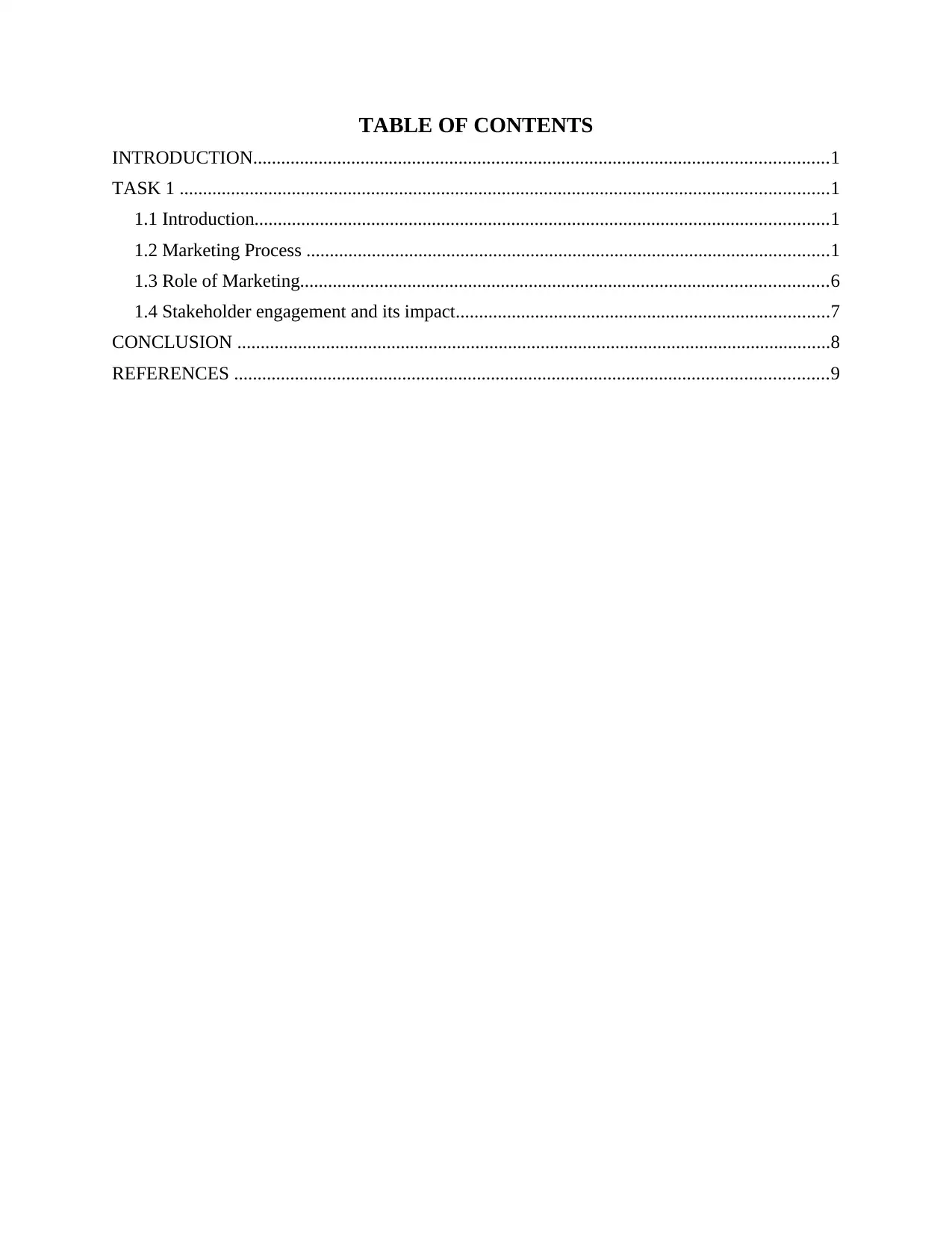
TABLE OF CONTENTS
INTRODUCTION...........................................................................................................................1
TASK 1 ...........................................................................................................................................1
1.1 Introduction...........................................................................................................................1
1.2 Marketing Process ................................................................................................................1
1.3 Role of Marketing.................................................................................................................6
1.4 Stakeholder engagement and its impact................................................................................7
CONCLUSION ...............................................................................................................................8
REFERENCES ...............................................................................................................................9
INTRODUCTION...........................................................................................................................1
TASK 1 ...........................................................................................................................................1
1.1 Introduction...........................................................................................................................1
1.2 Marketing Process ................................................................................................................1
1.3 Role of Marketing.................................................................................................................6
1.4 Stakeholder engagement and its impact................................................................................7
CONCLUSION ...............................................................................................................................8
REFERENCES ...............................................................................................................................9
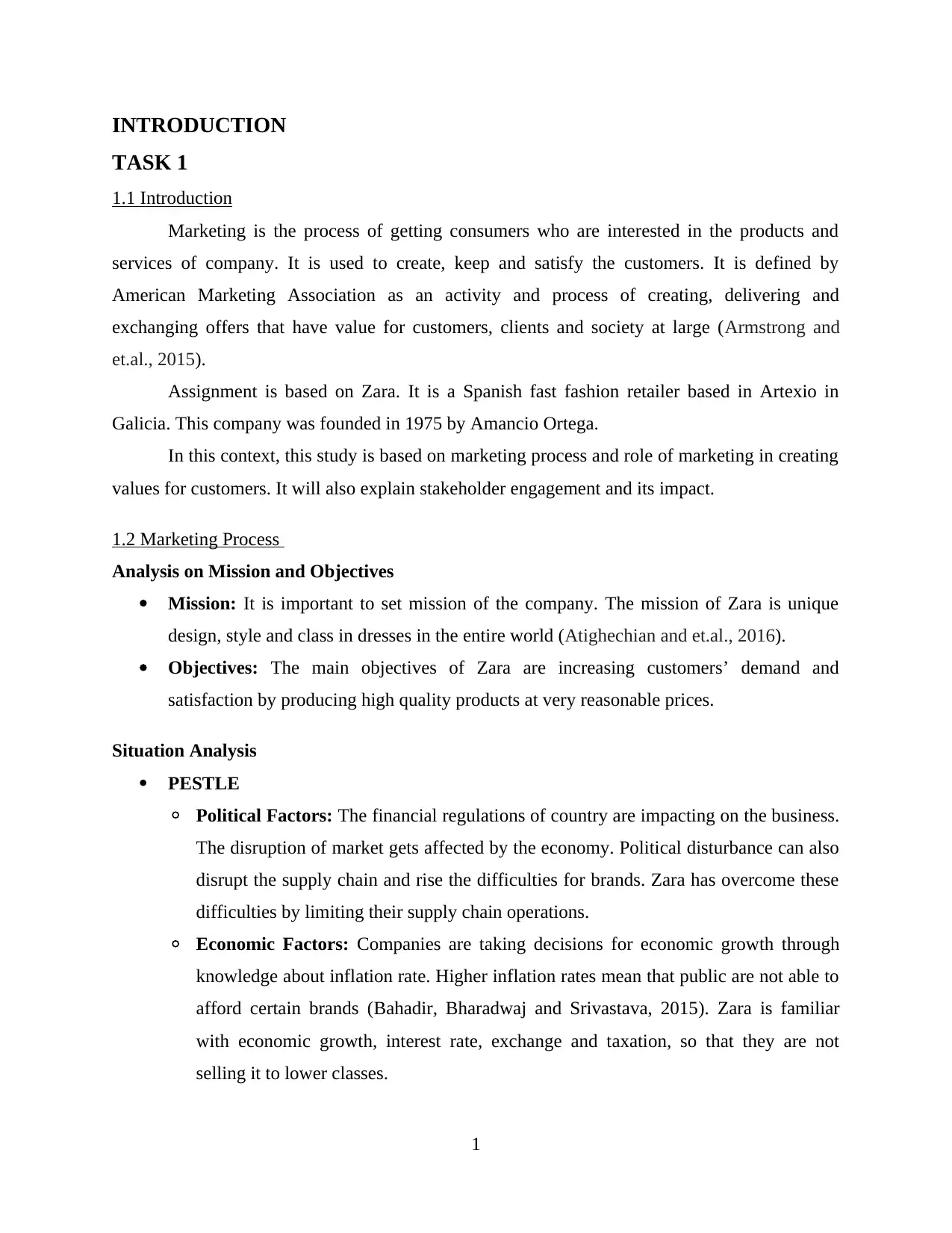
INTRODUCTION
TASK 1
1.1 Introduction
Marketing is the process of getting consumers who are interested in the products and
services of company. It is used to create, keep and satisfy the customers. It is defined by
American Marketing Association as an activity and process of creating, delivering and
exchanging offers that have value for customers, clients and society at large (Armstrong and
et.al., 2015).
Assignment is based on Zara. It is a Spanish fast fashion retailer based in Artexio in
Galicia. This company was founded in 1975 by Amancio Ortega.
In this context, this study is based on marketing process and role of marketing in creating
values for customers. It will also explain stakeholder engagement and its impact.
1.2 Marketing Process
Analysis on Mission and Objectives
Mission: It is important to set mission of the company. The mission of Zara is unique
design, style and class in dresses in the entire world (Atighechian and et.al., 2016).
Objectives: The main objectives of Zara are increasing customers’ demand and
satisfaction by producing high quality products at very reasonable prices.
Situation Analysis
PESTLE
◦ Political Factors: The financial regulations of country are impacting on the business.
The disruption of market gets affected by the economy. Political disturbance can also
disrupt the supply chain and rise the difficulties for brands. Zara has overcome these
difficulties by limiting their supply chain operations.
◦ Economic Factors: Companies are taking decisions for economic growth through
knowledge about inflation rate. Higher inflation rates mean that public are not able to
afford certain brands (Bahadir, Bharadwaj and Srivastava, 2015). Zara is familiar
with economic growth, interest rate, exchange and taxation, so that they are not
selling it to lower classes.
1
TASK 1
1.1 Introduction
Marketing is the process of getting consumers who are interested in the products and
services of company. It is used to create, keep and satisfy the customers. It is defined by
American Marketing Association as an activity and process of creating, delivering and
exchanging offers that have value for customers, clients and society at large (Armstrong and
et.al., 2015).
Assignment is based on Zara. It is a Spanish fast fashion retailer based in Artexio in
Galicia. This company was founded in 1975 by Amancio Ortega.
In this context, this study is based on marketing process and role of marketing in creating
values for customers. It will also explain stakeholder engagement and its impact.
1.2 Marketing Process
Analysis on Mission and Objectives
Mission: It is important to set mission of the company. The mission of Zara is unique
design, style and class in dresses in the entire world (Atighechian and et.al., 2016).
Objectives: The main objectives of Zara are increasing customers’ demand and
satisfaction by producing high quality products at very reasonable prices.
Situation Analysis
PESTLE
◦ Political Factors: The financial regulations of country are impacting on the business.
The disruption of market gets affected by the economy. Political disturbance can also
disrupt the supply chain and rise the difficulties for brands. Zara has overcome these
difficulties by limiting their supply chain operations.
◦ Economic Factors: Companies are taking decisions for economic growth through
knowledge about inflation rate. Higher inflation rates mean that public are not able to
afford certain brands (Bahadir, Bharadwaj and Srivastava, 2015). Zara is familiar
with economic growth, interest rate, exchange and taxation, so that they are not
selling it to lower classes.
1
⊘ This is a preview!⊘
Do you want full access?
Subscribe today to unlock all pages.

Trusted by 1+ million students worldwide
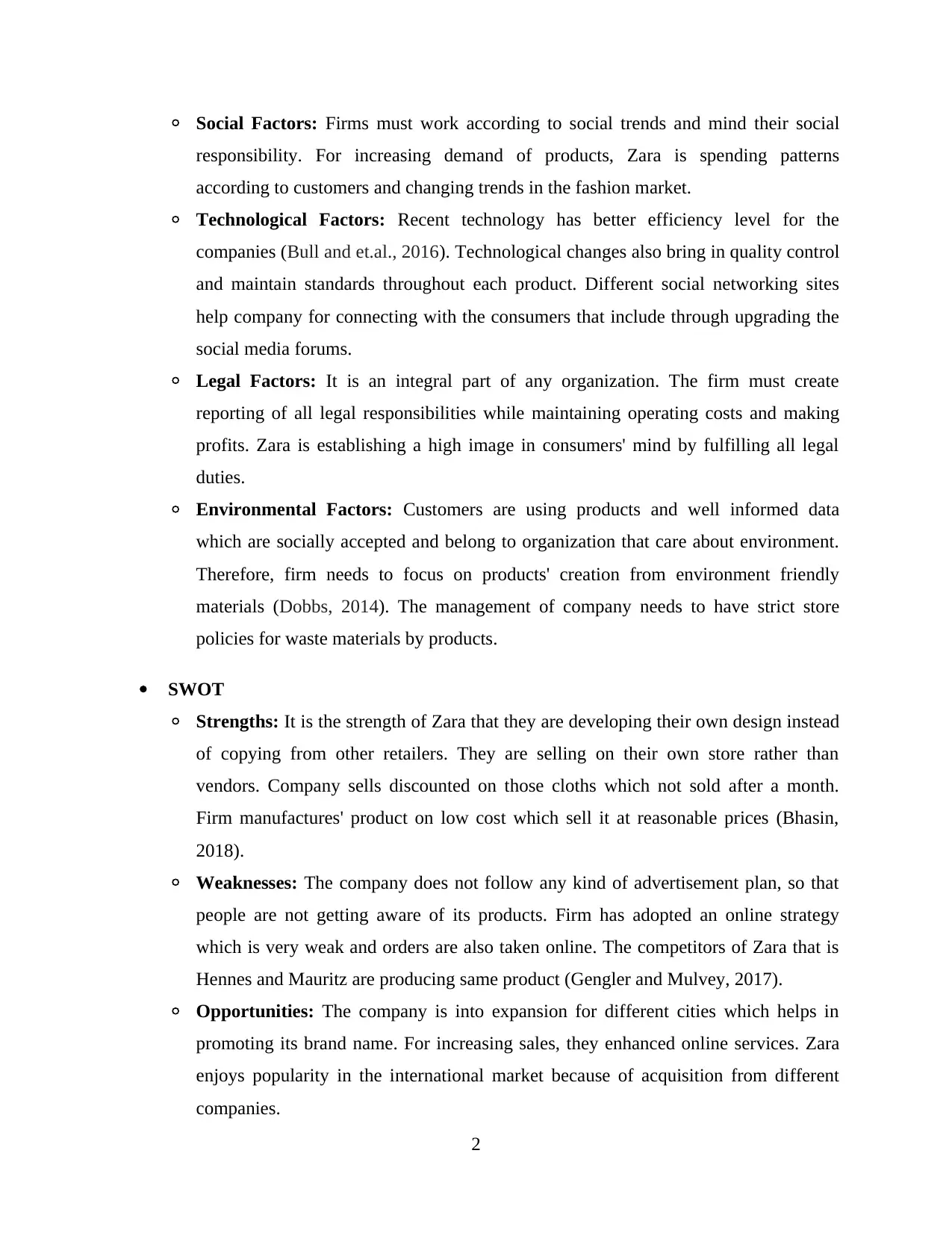
◦ Social Factors: Firms must work according to social trends and mind their social
responsibility. For increasing demand of products, Zara is spending patterns
according to customers and changing trends in the fashion market.
◦ Technological Factors: Recent technology has better efficiency level for the
companies (Bull and et.al., 2016). Technological changes also bring in quality control
and maintain standards throughout each product. Different social networking sites
help company for connecting with the consumers that include through upgrading the
social media forums.
◦ Legal Factors: It is an integral part of any organization. The firm must create
reporting of all legal responsibilities while maintaining operating costs and making
profits. Zara is establishing a high image in consumers' mind by fulfilling all legal
duties.
◦ Environmental Factors: Customers are using products and well informed data
which are socially accepted and belong to organization that care about environment.
Therefore, firm needs to focus on products' creation from environment friendly
materials (Dobbs, 2014). The management of company needs to have strict store
policies for waste materials by products.
SWOT
◦ Strengths: It is the strength of Zara that they are developing their own design instead
of copying from other retailers. They are selling on their own store rather than
vendors. Company sells discounted on those cloths which not sold after a month.
Firm manufactures' product on low cost which sell it at reasonable prices (Bhasin,
2018).
◦ Weaknesses: The company does not follow any kind of advertisement plan, so that
people are not getting aware of its products. Firm has adopted an online strategy
which is very weak and orders are also taken online. The competitors of Zara that is
Hennes and Mauritz are producing same product (Gengler and Mulvey, 2017).
◦ Opportunities: The company is into expansion for different cities which helps in
promoting its brand name. For increasing sales, they enhanced online services. Zara
enjoys popularity in the international market because of acquisition from different
companies.
2
responsibility. For increasing demand of products, Zara is spending patterns
according to customers and changing trends in the fashion market.
◦ Technological Factors: Recent technology has better efficiency level for the
companies (Bull and et.al., 2016). Technological changes also bring in quality control
and maintain standards throughout each product. Different social networking sites
help company for connecting with the consumers that include through upgrading the
social media forums.
◦ Legal Factors: It is an integral part of any organization. The firm must create
reporting of all legal responsibilities while maintaining operating costs and making
profits. Zara is establishing a high image in consumers' mind by fulfilling all legal
duties.
◦ Environmental Factors: Customers are using products and well informed data
which are socially accepted and belong to organization that care about environment.
Therefore, firm needs to focus on products' creation from environment friendly
materials (Dobbs, 2014). The management of company needs to have strict store
policies for waste materials by products.
SWOT
◦ Strengths: It is the strength of Zara that they are developing their own design instead
of copying from other retailers. They are selling on their own store rather than
vendors. Company sells discounted on those cloths which not sold after a month.
Firm manufactures' product on low cost which sell it at reasonable prices (Bhasin,
2018).
◦ Weaknesses: The company does not follow any kind of advertisement plan, so that
people are not getting aware of its products. Firm has adopted an online strategy
which is very weak and orders are also taken online. The competitors of Zara that is
Hennes and Mauritz are producing same product (Gengler and Mulvey, 2017).
◦ Opportunities: The company is into expansion for different cities which helps in
promoting its brand name. For increasing sales, they enhanced online services. Zara
enjoys popularity in the international market because of acquisition from different
companies.
2
Paraphrase This Document
Need a fresh take? Get an instant paraphrase of this document with our AI Paraphraser
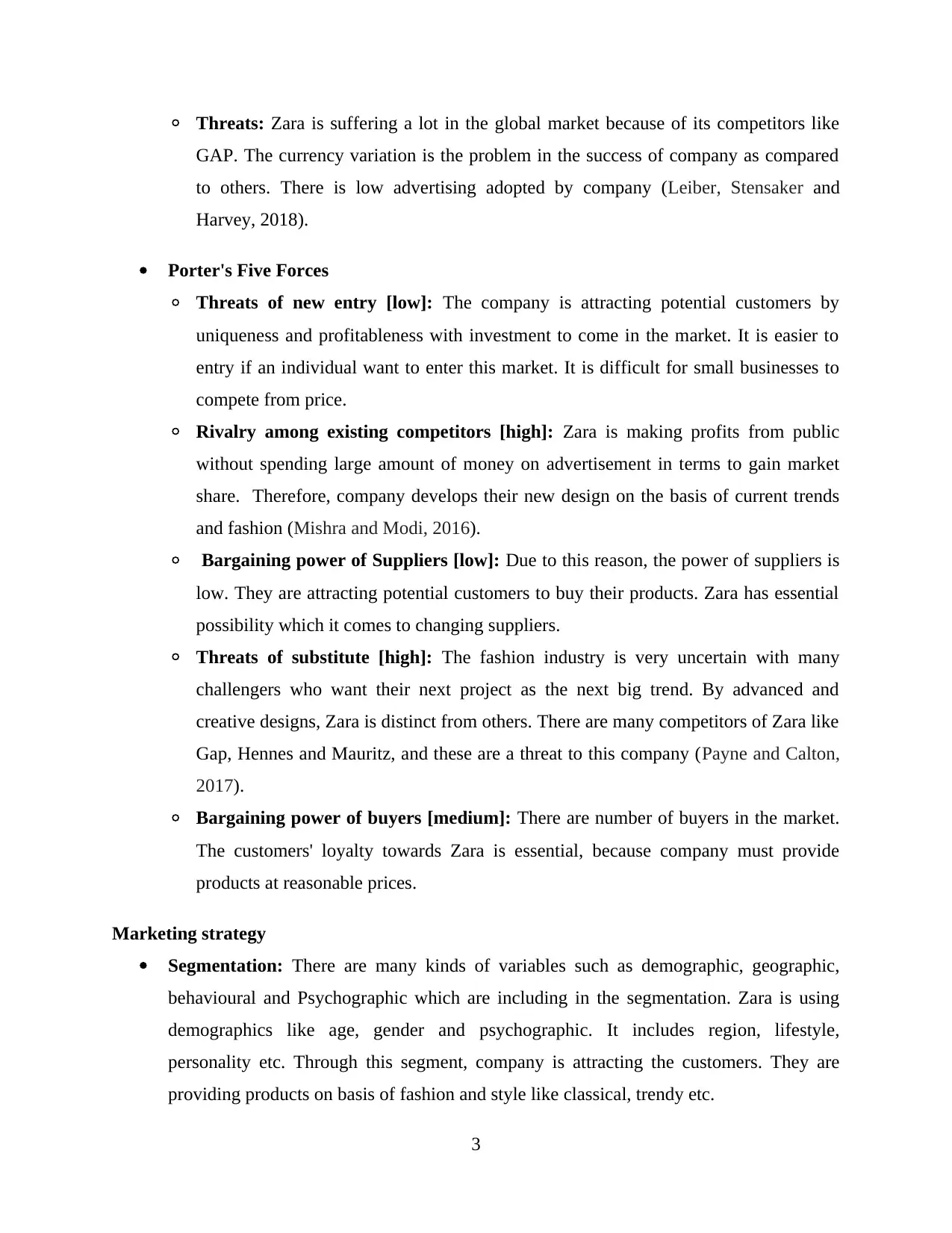
◦ Threats: Zara is suffering a lot in the global market because of its competitors like
GAP. The currency variation is the problem in the success of company as compared
to others. There is low advertising adopted by company (Leiber, Stensaker and
Harvey, 2018).
Porter's Five Forces
◦ Threats of new entry [low]: The company is attracting potential customers by
uniqueness and profitableness with investment to come in the market. It is easier to
entry if an individual want to enter this market. It is difficult for small businesses to
compete from price.
◦ Rivalry among existing competitors [high]: Zara is making profits from public
without spending large amount of money on advertisement in terms to gain market
share. Therefore, company develops their new design on the basis of current trends
and fashion (Mishra and Modi, 2016).
◦ Bargaining power of Suppliers [low]: Due to this reason, the power of suppliers is
low. They are attracting potential customers to buy their products. Zara has essential
possibility which it comes to changing suppliers.
◦ Threats of substitute [high]: The fashion industry is very uncertain with many
challengers who want their next project as the next big trend. By advanced and
creative designs, Zara is distinct from others. There are many competitors of Zara like
Gap, Hennes and Mauritz, and these are a threat to this company (Payne and Calton,
2017).
◦ Bargaining power of buyers [medium]: There are number of buyers in the market.
The customers' loyalty towards Zara is essential, because company must provide
products at reasonable prices.
Marketing strategy
Segmentation: There are many kinds of variables such as demographic, geographic,
behavioural and Psychographic which are including in the segmentation. Zara is using
demographics like age, gender and psychographic. It includes region, lifestyle,
personality etc. Through this segment, company is attracting the customers. They are
providing products on basis of fashion and style like classical, trendy etc.
3
GAP. The currency variation is the problem in the success of company as compared
to others. There is low advertising adopted by company (Leiber, Stensaker and
Harvey, 2018).
Porter's Five Forces
◦ Threats of new entry [low]: The company is attracting potential customers by
uniqueness and profitableness with investment to come in the market. It is easier to
entry if an individual want to enter this market. It is difficult for small businesses to
compete from price.
◦ Rivalry among existing competitors [high]: Zara is making profits from public
without spending large amount of money on advertisement in terms to gain market
share. Therefore, company develops their new design on the basis of current trends
and fashion (Mishra and Modi, 2016).
◦ Bargaining power of Suppliers [low]: Due to this reason, the power of suppliers is
low. They are attracting potential customers to buy their products. Zara has essential
possibility which it comes to changing suppliers.
◦ Threats of substitute [high]: The fashion industry is very uncertain with many
challengers who want their next project as the next big trend. By advanced and
creative designs, Zara is distinct from others. There are many competitors of Zara like
Gap, Hennes and Mauritz, and these are a threat to this company (Payne and Calton,
2017).
◦ Bargaining power of buyers [medium]: There are number of buyers in the market.
The customers' loyalty towards Zara is essential, because company must provide
products at reasonable prices.
Marketing strategy
Segmentation: There are many kinds of variables such as demographic, geographic,
behavioural and Psychographic which are including in the segmentation. Zara is using
demographics like age, gender and psychographic. It includes region, lifestyle,
personality etc. Through this segment, company is attracting the customers. They are
providing products on basis of fashion and style like classical, trendy etc.
3
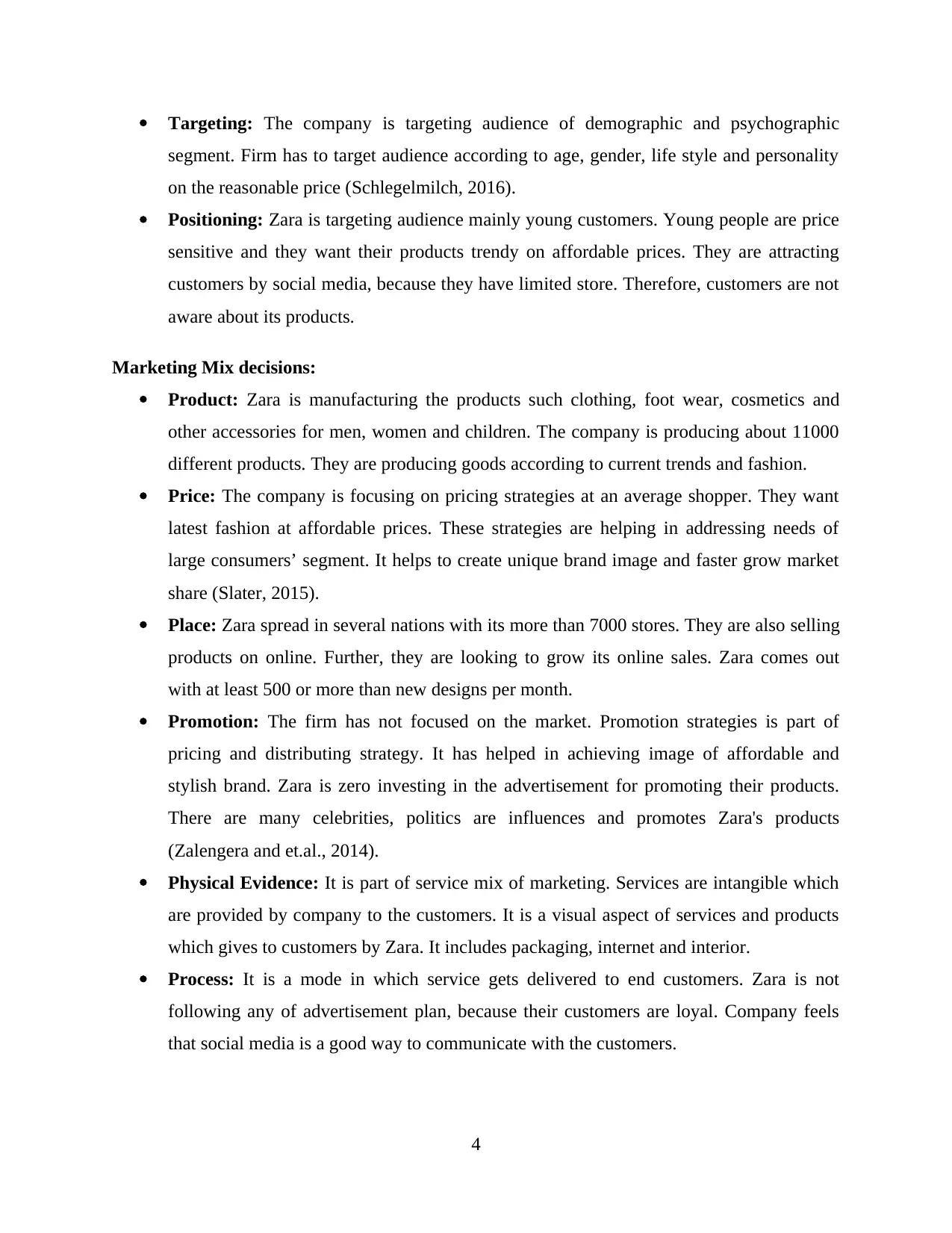
Targeting: The company is targeting audience of demographic and psychographic
segment. Firm has to target audience according to age, gender, life style and personality
on the reasonable price (Schlegelmilch, 2016).
Positioning: Zara is targeting audience mainly young customers. Young people are price
sensitive and they want their products trendy on affordable prices. They are attracting
customers by social media, because they have limited store. Therefore, customers are not
aware about its products.
Marketing Mix decisions:
Product: Zara is manufacturing the products such clothing, foot wear, cosmetics and
other accessories for men, women and children. The company is producing about 11000
different products. They are producing goods according to current trends and fashion.
Price: The company is focusing on pricing strategies at an average shopper. They want
latest fashion at affordable prices. These strategies are helping in addressing needs of
large consumers’ segment. It helps to create unique brand image and faster grow market
share (Slater, 2015).
Place: Zara spread in several nations with its more than 7000 stores. They are also selling
products on online. Further, they are looking to grow its online sales. Zara comes out
with at least 500 or more than new designs per month.
Promotion: The firm has not focused on the market. Promotion strategies is part of
pricing and distributing strategy. It has helped in achieving image of affordable and
stylish brand. Zara is zero investing in the advertisement for promoting their products.
There are many celebrities, politics are influences and promotes Zara's products
(Zalengera and et.al., 2014).
Physical Evidence: It is part of service mix of marketing. Services are intangible which
are provided by company to the customers. It is a visual aspect of services and products
which gives to customers by Zara. It includes packaging, internet and interior.
Process: It is a mode in which service gets delivered to end customers. Zara is not
following any of advertisement plan, because their customers are loyal. Company feels
that social media is a good way to communicate with the customers.
4
segment. Firm has to target audience according to age, gender, life style and personality
on the reasonable price (Schlegelmilch, 2016).
Positioning: Zara is targeting audience mainly young customers. Young people are price
sensitive and they want their products trendy on affordable prices. They are attracting
customers by social media, because they have limited store. Therefore, customers are not
aware about its products.
Marketing Mix decisions:
Product: Zara is manufacturing the products such clothing, foot wear, cosmetics and
other accessories for men, women and children. The company is producing about 11000
different products. They are producing goods according to current trends and fashion.
Price: The company is focusing on pricing strategies at an average shopper. They want
latest fashion at affordable prices. These strategies are helping in addressing needs of
large consumers’ segment. It helps to create unique brand image and faster grow market
share (Slater, 2015).
Place: Zara spread in several nations with its more than 7000 stores. They are also selling
products on online. Further, they are looking to grow its online sales. Zara comes out
with at least 500 or more than new designs per month.
Promotion: The firm has not focused on the market. Promotion strategies is part of
pricing and distributing strategy. It has helped in achieving image of affordable and
stylish brand. Zara is zero investing in the advertisement for promoting their products.
There are many celebrities, politics are influences and promotes Zara's products
(Zalengera and et.al., 2014).
Physical Evidence: It is part of service mix of marketing. Services are intangible which
are provided by company to the customers. It is a visual aspect of services and products
which gives to customers by Zara. It includes packaging, internet and interior.
Process: It is a mode in which service gets delivered to end customers. Zara is not
following any of advertisement plan, because their customers are loyal. Company feels
that social media is a good way to communicate with the customers.
4
⊘ This is a preview!⊘
Do you want full access?
Subscribe today to unlock all pages.

Trusted by 1+ million students worldwide
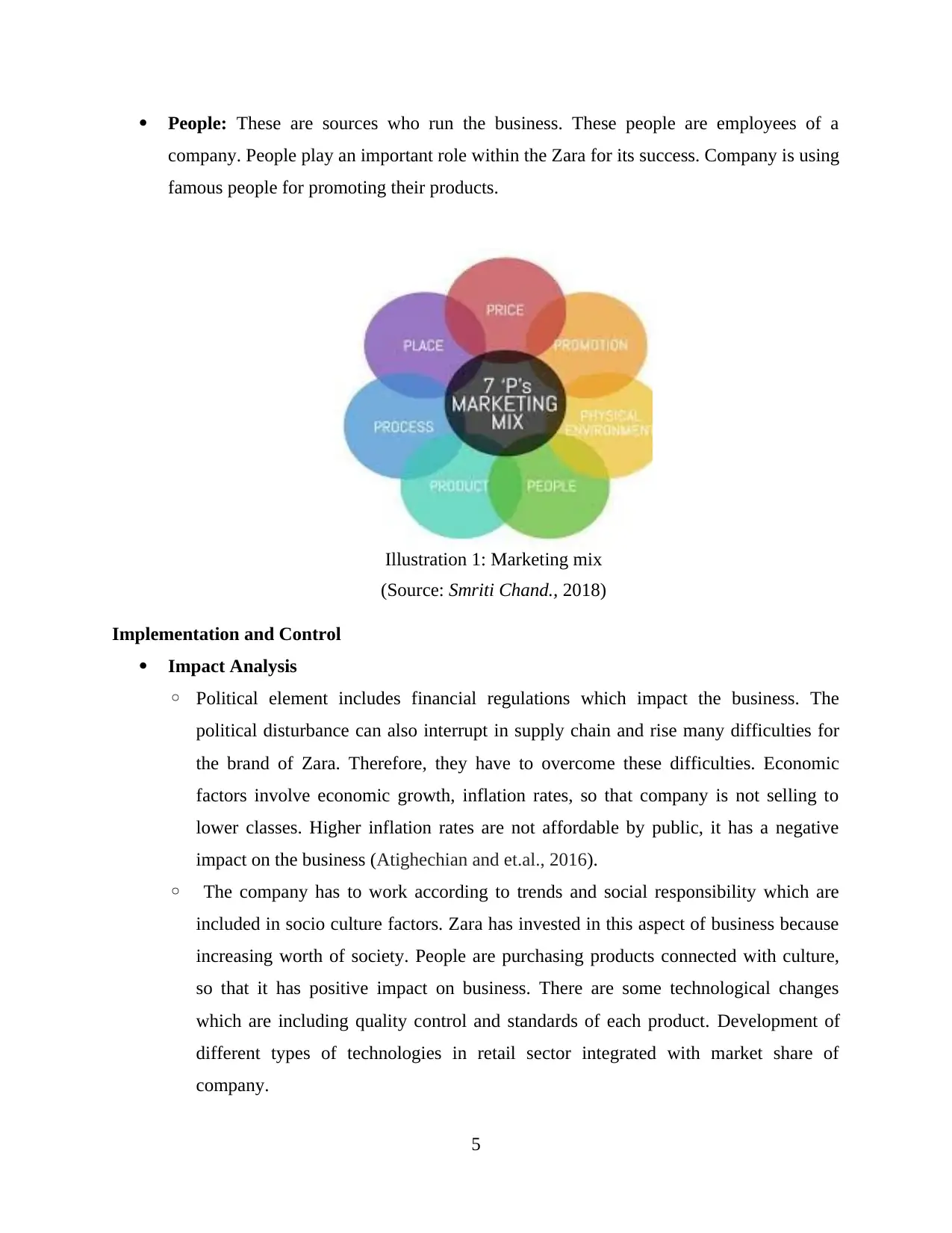
People: These are sources who run the business. These people are employees of a
company. People play an important role within the Zara for its success. Company is using
famous people for promoting their products.
Implementation and Control
Impact Analysis
◦ Political element includes financial regulations which impact the business. The
political disturbance can also interrupt in supply chain and rise many difficulties for
the brand of Zara. Therefore, they have to overcome these difficulties. Economic
factors involve economic growth, inflation rates, so that company is not selling to
lower classes. Higher inflation rates are not affordable by public, it has a negative
impact on the business (Atighechian and et.al., 2016).
◦ The company has to work according to trends and social responsibility which are
included in socio culture factors. Zara has invested in this aspect of business because
increasing worth of society. People are purchasing products connected with culture,
so that it has positive impact on business. There are some technological changes
which are including quality control and standards of each product. Development of
different types of technologies in retail sector integrated with market share of
company.
5
Illustration 1: Marketing mix
(Source: Smriti Chand., 2018)
company. People play an important role within the Zara for its success. Company is using
famous people for promoting their products.
Implementation and Control
Impact Analysis
◦ Political element includes financial regulations which impact the business. The
political disturbance can also interrupt in supply chain and rise many difficulties for
the brand of Zara. Therefore, they have to overcome these difficulties. Economic
factors involve economic growth, inflation rates, so that company is not selling to
lower classes. Higher inflation rates are not affordable by public, it has a negative
impact on the business (Atighechian and et.al., 2016).
◦ The company has to work according to trends and social responsibility which are
included in socio culture factors. Zara has invested in this aspect of business because
increasing worth of society. People are purchasing products connected with culture,
so that it has positive impact on business. There are some technological changes
which are including quality control and standards of each product. Development of
different types of technologies in retail sector integrated with market share of
company.
5
Illustration 1: Marketing mix
(Source: Smriti Chand., 2018)
Paraphrase This Document
Need a fresh take? Get an instant paraphrase of this document with our AI Paraphraser
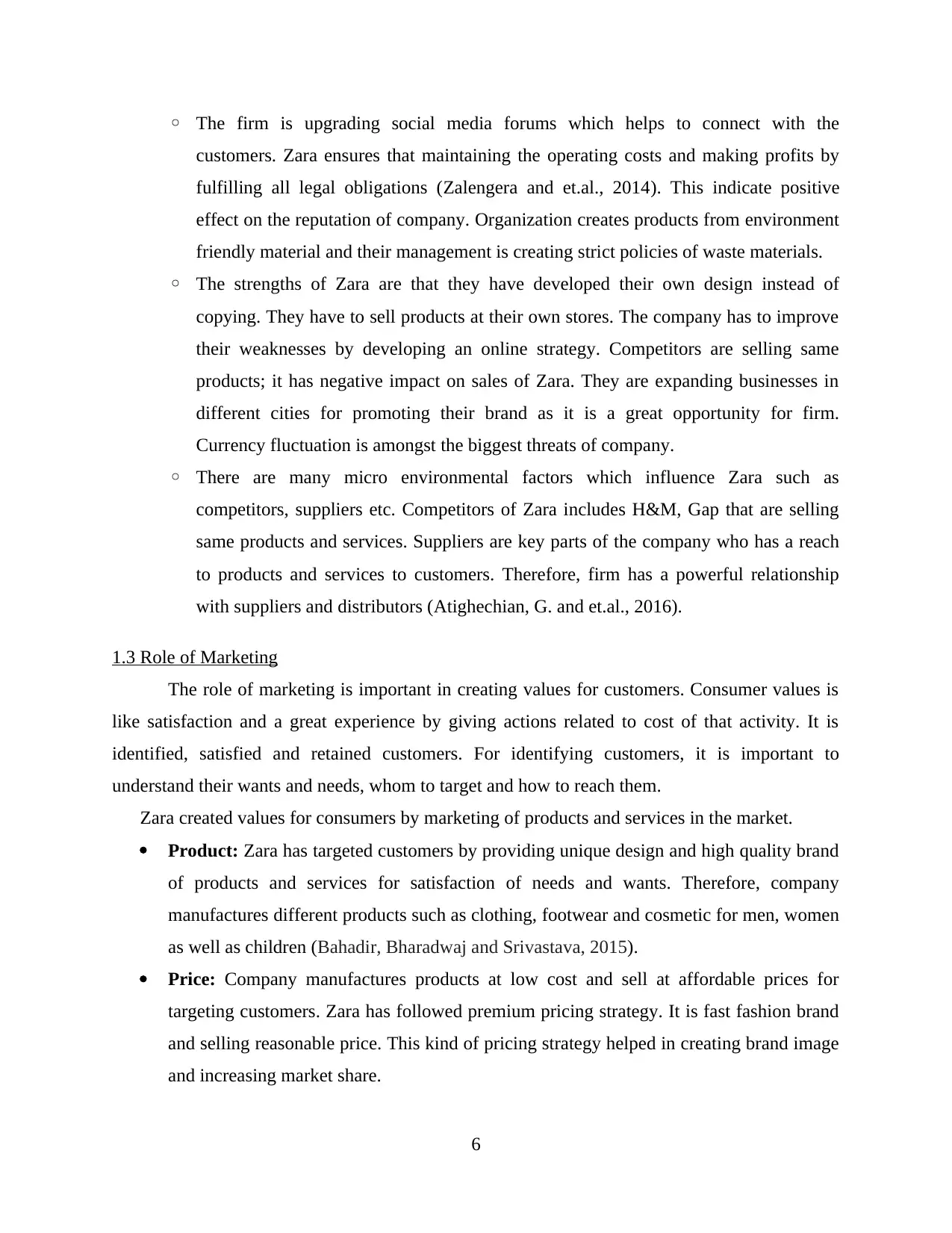
◦ The firm is upgrading social media forums which helps to connect with the
customers. Zara ensures that maintaining the operating costs and making profits by
fulfilling all legal obligations (Zalengera and et.al., 2014). This indicate positive
effect on the reputation of company. Organization creates products from environment
friendly material and their management is creating strict policies of waste materials.
◦ The strengths of Zara are that they have developed their own design instead of
copying. They have to sell products at their own stores. The company has to improve
their weaknesses by developing an online strategy. Competitors are selling same
products; it has negative impact on sales of Zara. They are expanding businesses in
different cities for promoting their brand as it is a great opportunity for firm.
Currency fluctuation is amongst the biggest threats of company.
◦ There are many micro environmental factors which influence Zara such as
competitors, suppliers etc. Competitors of Zara includes H&M, Gap that are selling
same products and services. Suppliers are key parts of the company who has a reach
to products and services to customers. Therefore, firm has a powerful relationship
with suppliers and distributors (Atighechian, G. and et.al., 2016).
1.3 Role of Marketing
The role of marketing is important in creating values for customers. Consumer values is
like satisfaction and a great experience by giving actions related to cost of that activity. It is
identified, satisfied and retained customers. For identifying customers, it is important to
understand their wants and needs, whom to target and how to reach them.
Zara created values for consumers by marketing of products and services in the market.
Product: Zara has targeted customers by providing unique design and high quality brand
of products and services for satisfaction of needs and wants. Therefore, company
manufactures different products such as clothing, footwear and cosmetic for men, women
as well as children (Bahadir, Bharadwaj and Srivastava, 2015).
Price: Company manufactures products at low cost and sell at affordable prices for
targeting customers. Zara has followed premium pricing strategy. It is fast fashion brand
and selling reasonable price. This kind of pricing strategy helped in creating brand image
and increasing market share.
6
customers. Zara ensures that maintaining the operating costs and making profits by
fulfilling all legal obligations (Zalengera and et.al., 2014). This indicate positive
effect on the reputation of company. Organization creates products from environment
friendly material and their management is creating strict policies of waste materials.
◦ The strengths of Zara are that they have developed their own design instead of
copying. They have to sell products at their own stores. The company has to improve
their weaknesses by developing an online strategy. Competitors are selling same
products; it has negative impact on sales of Zara. They are expanding businesses in
different cities for promoting their brand as it is a great opportunity for firm.
Currency fluctuation is amongst the biggest threats of company.
◦ There are many micro environmental factors which influence Zara such as
competitors, suppliers etc. Competitors of Zara includes H&M, Gap that are selling
same products and services. Suppliers are key parts of the company who has a reach
to products and services to customers. Therefore, firm has a powerful relationship
with suppliers and distributors (Atighechian, G. and et.al., 2016).
1.3 Role of Marketing
The role of marketing is important in creating values for customers. Consumer values is
like satisfaction and a great experience by giving actions related to cost of that activity. It is
identified, satisfied and retained customers. For identifying customers, it is important to
understand their wants and needs, whom to target and how to reach them.
Zara created values for consumers by marketing of products and services in the market.
Product: Zara has targeted customers by providing unique design and high quality brand
of products and services for satisfaction of needs and wants. Therefore, company
manufactures different products such as clothing, footwear and cosmetic for men, women
as well as children (Bahadir, Bharadwaj and Srivastava, 2015).
Price: Company manufactures products at low cost and sell at affordable prices for
targeting customers. Zara has followed premium pricing strategy. It is fast fashion brand
and selling reasonable price. This kind of pricing strategy helped in creating brand image
and increasing market share.
6
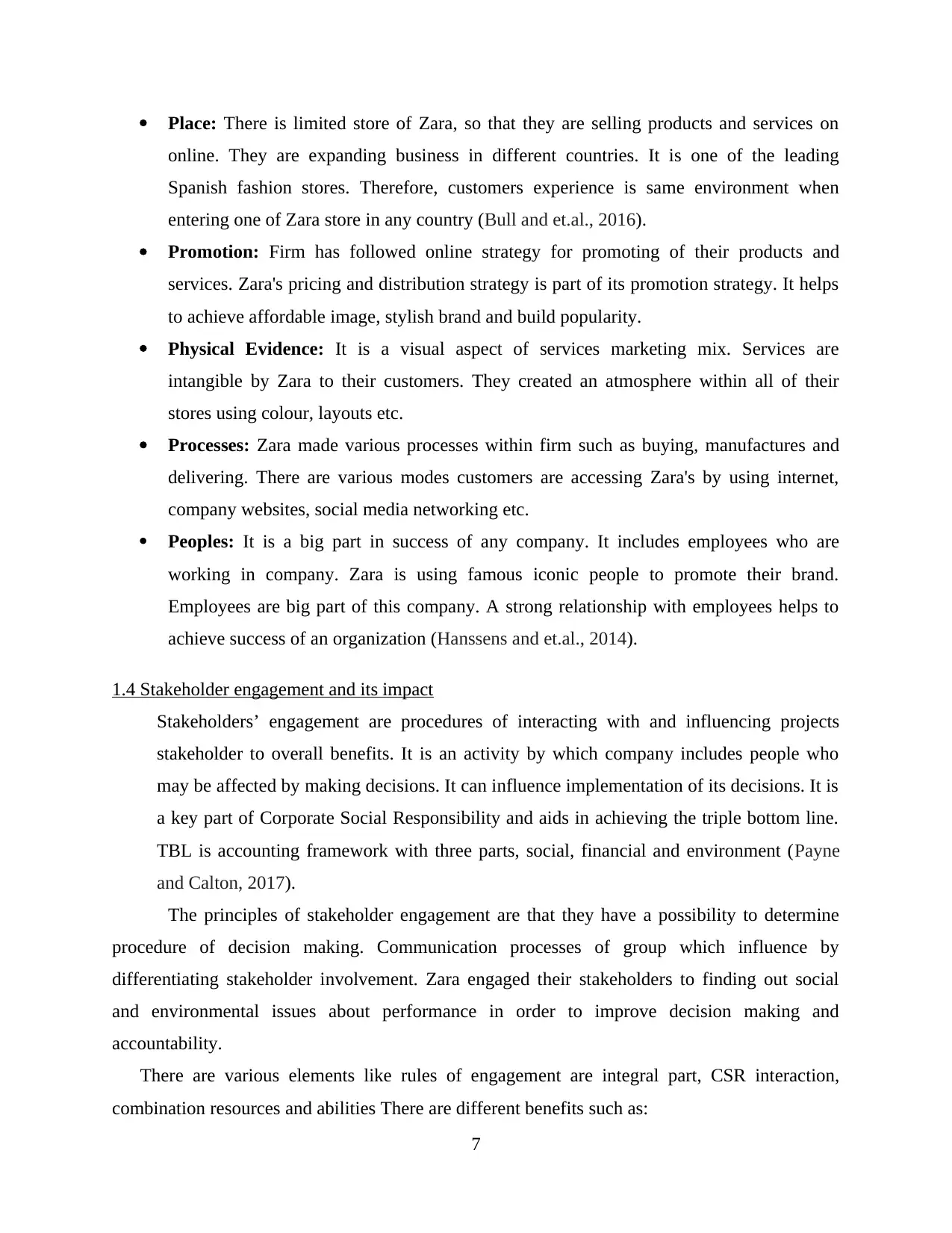
Place: There is limited store of Zara, so that they are selling products and services on
online. They are expanding business in different countries. It is one of the leading
Spanish fashion stores. Therefore, customers experience is same environment when
entering one of Zara store in any country (Bull and et.al., 2016).
Promotion: Firm has followed online strategy for promoting of their products and
services. Zara's pricing and distribution strategy is part of its promotion strategy. It helps
to achieve affordable image, stylish brand and build popularity.
Physical Evidence: It is a visual aspect of services marketing mix. Services are
intangible by Zara to their customers. They created an atmosphere within all of their
stores using colour, layouts etc.
Processes: Zara made various processes within firm such as buying, manufactures and
delivering. There are various modes customers are accessing Zara's by using internet,
company websites, social media networking etc.
Peoples: It is a big part in success of any company. It includes employees who are
working in company. Zara is using famous iconic people to promote their brand.
Employees are big part of this company. A strong relationship with employees helps to
achieve success of an organization (Hanssens and et.al., 2014).
1.4 Stakeholder engagement and its impact
Stakeholders’ engagement are procedures of interacting with and influencing projects
stakeholder to overall benefits. It is an activity by which company includes people who
may be affected by making decisions. It can influence implementation of its decisions. It is
a key part of Corporate Social Responsibility and aids in achieving the triple bottom line.
TBL is accounting framework with three parts, social, financial and environment (Payne
and Calton, 2017).
The principles of stakeholder engagement are that they have a possibility to determine
procedure of decision making. Communication processes of group which influence by
differentiating stakeholder involvement. Zara engaged their stakeholders to finding out social
and environmental issues about performance in order to improve decision making and
accountability.
There are various elements like rules of engagement are integral part, CSR interaction,
combination resources and abilities There are different benefits such as:
7
online. They are expanding business in different countries. It is one of the leading
Spanish fashion stores. Therefore, customers experience is same environment when
entering one of Zara store in any country (Bull and et.al., 2016).
Promotion: Firm has followed online strategy for promoting of their products and
services. Zara's pricing and distribution strategy is part of its promotion strategy. It helps
to achieve affordable image, stylish brand and build popularity.
Physical Evidence: It is a visual aspect of services marketing mix. Services are
intangible by Zara to their customers. They created an atmosphere within all of their
stores using colour, layouts etc.
Processes: Zara made various processes within firm such as buying, manufactures and
delivering. There are various modes customers are accessing Zara's by using internet,
company websites, social media networking etc.
Peoples: It is a big part in success of any company. It includes employees who are
working in company. Zara is using famous iconic people to promote their brand.
Employees are big part of this company. A strong relationship with employees helps to
achieve success of an organization (Hanssens and et.al., 2014).
1.4 Stakeholder engagement and its impact
Stakeholders’ engagement are procedures of interacting with and influencing projects
stakeholder to overall benefits. It is an activity by which company includes people who
may be affected by making decisions. It can influence implementation of its decisions. It is
a key part of Corporate Social Responsibility and aids in achieving the triple bottom line.
TBL is accounting framework with three parts, social, financial and environment (Payne
and Calton, 2017).
The principles of stakeholder engagement are that they have a possibility to determine
procedure of decision making. Communication processes of group which influence by
differentiating stakeholder involvement. Zara engaged their stakeholders to finding out social
and environmental issues about performance in order to improve decision making and
accountability.
There are various elements like rules of engagement are integral part, CSR interaction,
combination resources and abilities There are different benefits such as:
7
⊘ This is a preview!⊘
Do you want full access?
Subscribe today to unlock all pages.

Trusted by 1+ million students worldwide
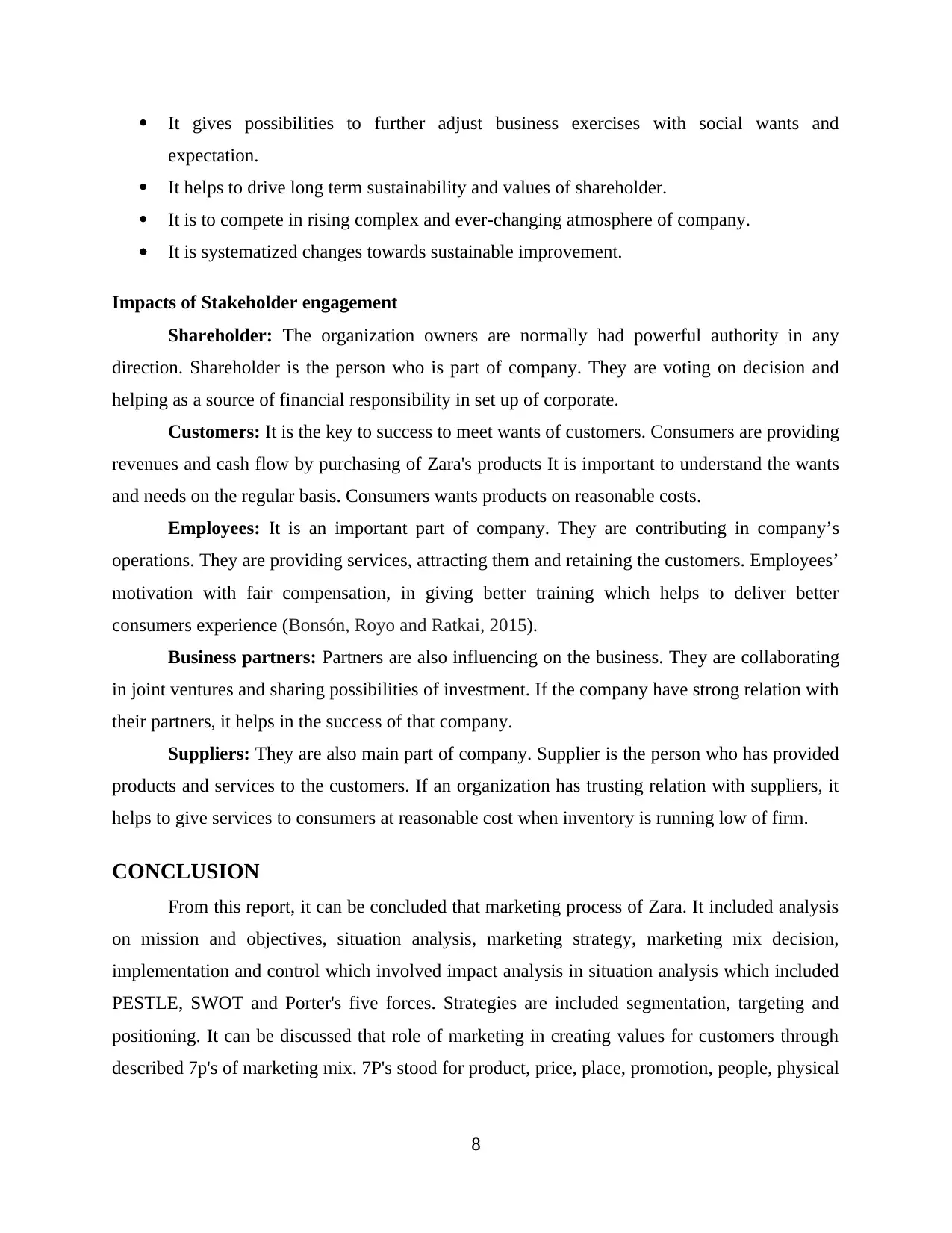
It gives possibilities to further adjust business exercises with social wants and
expectation.
It helps to drive long term sustainability and values of shareholder.
It is to compete in rising complex and ever-changing atmosphere of company.
It is systematized changes towards sustainable improvement.
Impacts of Stakeholder engagement
Shareholder: The organization owners are normally had powerful authority in any
direction. Shareholder is the person who is part of company. They are voting on decision and
helping as a source of financial responsibility in set up of corporate.
Customers: It is the key to success to meet wants of customers. Consumers are providing
revenues and cash flow by purchasing of Zara's products It is important to understand the wants
and needs on the regular basis. Consumers wants products on reasonable costs.
Employees: It is an important part of company. They are contributing in company’s
operations. They are providing services, attracting them and retaining the customers. Employees’
motivation with fair compensation, in giving better training which helps to deliver better
consumers experience (Bonsón, Royo and Ratkai, 2015).
Business partners: Partners are also influencing on the business. They are collaborating
in joint ventures and sharing possibilities of investment. If the company have strong relation with
their partners, it helps in the success of that company.
Suppliers: They are also main part of company. Supplier is the person who has provided
products and services to the customers. If an organization has trusting relation with suppliers, it
helps to give services to consumers at reasonable cost when inventory is running low of firm.
CONCLUSION
From this report, it can be concluded that marketing process of Zara. It included analysis
on mission and objectives, situation analysis, marketing strategy, marketing mix decision,
implementation and control which involved impact analysis in situation analysis which included
PESTLE, SWOT and Porter's five forces. Strategies are included segmentation, targeting and
positioning. It can be discussed that role of marketing in creating values for customers through
described 7p's of marketing mix. 7P's stood for product, price, place, promotion, people, physical
8
expectation.
It helps to drive long term sustainability and values of shareholder.
It is to compete in rising complex and ever-changing atmosphere of company.
It is systematized changes towards sustainable improvement.
Impacts of Stakeholder engagement
Shareholder: The organization owners are normally had powerful authority in any
direction. Shareholder is the person who is part of company. They are voting on decision and
helping as a source of financial responsibility in set up of corporate.
Customers: It is the key to success to meet wants of customers. Consumers are providing
revenues and cash flow by purchasing of Zara's products It is important to understand the wants
and needs on the regular basis. Consumers wants products on reasonable costs.
Employees: It is an important part of company. They are contributing in company’s
operations. They are providing services, attracting them and retaining the customers. Employees’
motivation with fair compensation, in giving better training which helps to deliver better
consumers experience (Bonsón, Royo and Ratkai, 2015).
Business partners: Partners are also influencing on the business. They are collaborating
in joint ventures and sharing possibilities of investment. If the company have strong relation with
their partners, it helps in the success of that company.
Suppliers: They are also main part of company. Supplier is the person who has provided
products and services to the customers. If an organization has trusting relation with suppliers, it
helps to give services to consumers at reasonable cost when inventory is running low of firm.
CONCLUSION
From this report, it can be concluded that marketing process of Zara. It included analysis
on mission and objectives, situation analysis, marketing strategy, marketing mix decision,
implementation and control which involved impact analysis in situation analysis which included
PESTLE, SWOT and Porter's five forces. Strategies are included segmentation, targeting and
positioning. It can be discussed that role of marketing in creating values for customers through
described 7p's of marketing mix. 7P's stood for product, price, place, promotion, people, physical
8
Paraphrase This Document
Need a fresh take? Get an instant paraphrase of this document with our AI Paraphraser
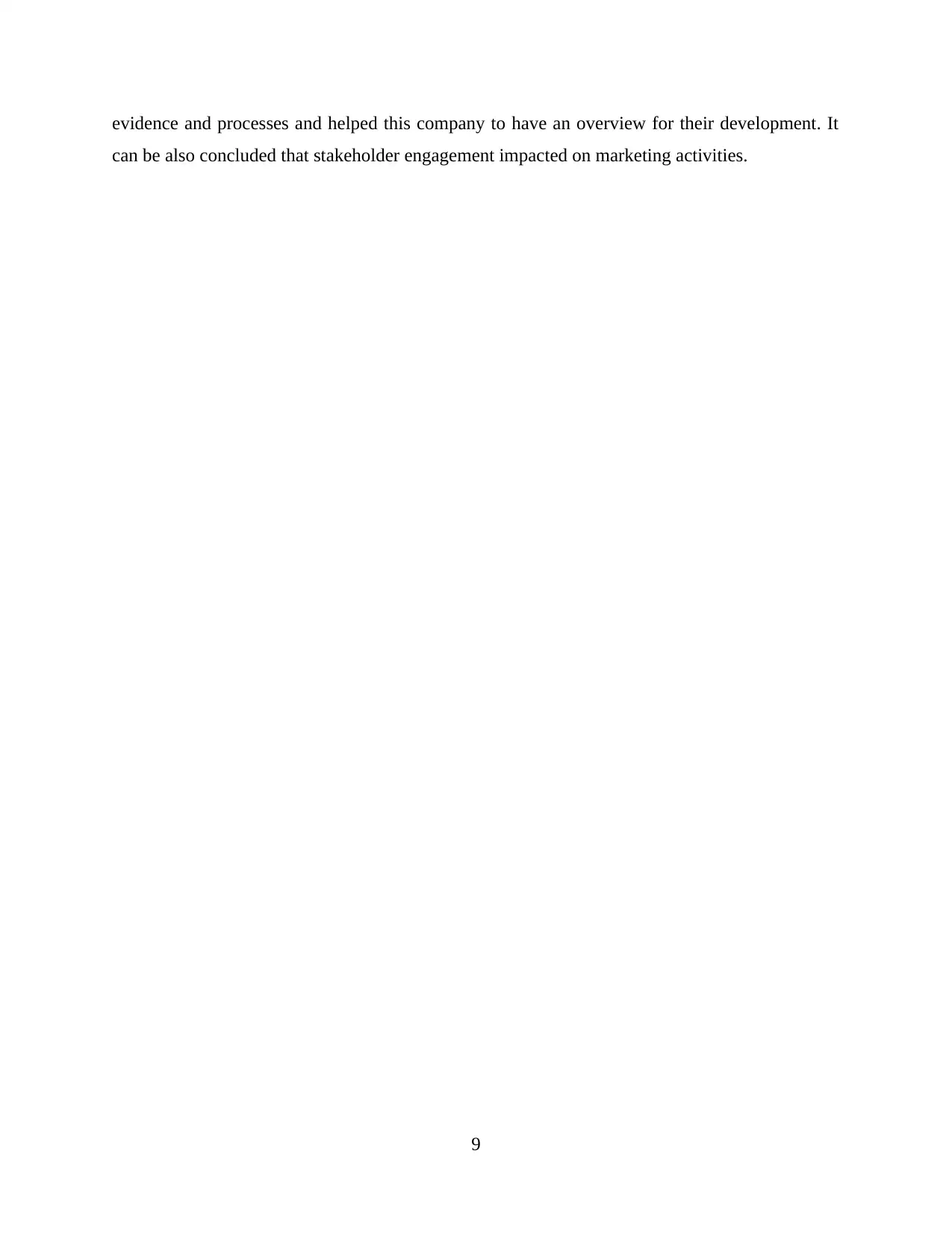
evidence and processes and helped this company to have an overview for their development. It
can be also concluded that stakeholder engagement impacted on marketing activities.
9
can be also concluded that stakeholder engagement impacted on marketing activities.
9
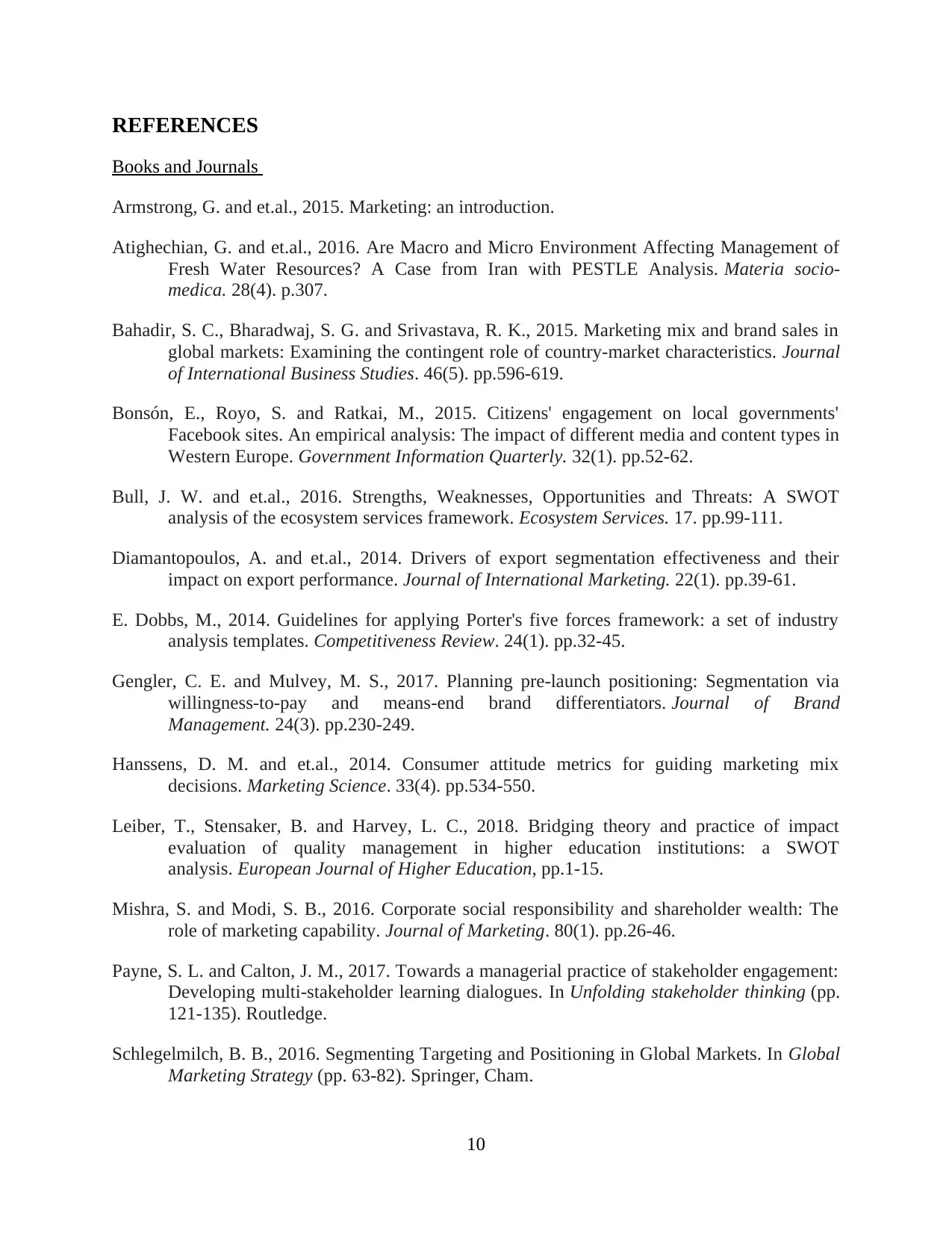
REFERENCES
Books and Journals
Armstrong, G. and et.al., 2015. Marketing: an introduction.
Atighechian, G. and et.al., 2016. Are Macro and Micro Environment Affecting Management of
Fresh Water Resources? A Case from Iran with PESTLE Analysis. Materia socio-
medica. 28(4). p.307.
Bahadir, S. C., Bharadwaj, S. G. and Srivastava, R. K., 2015. Marketing mix and brand sales in
global markets: Examining the contingent role of country-market characteristics. Journal
of International Business Studies. 46(5). pp.596-619.
Bonsón, E., Royo, S. and Ratkai, M., 2015. Citizens' engagement on local governments'
Facebook sites. An empirical analysis: The impact of different media and content types in
Western Europe. Government Information Quarterly. 32(1). pp.52-62.
Bull, J. W. and et.al., 2016. Strengths, Weaknesses, Opportunities and Threats: A SWOT
analysis of the ecosystem services framework. Ecosystem Services. 17. pp.99-111.
Diamantopoulos, A. and et.al., 2014. Drivers of export segmentation effectiveness and their
impact on export performance. Journal of International Marketing. 22(1). pp.39-61.
E. Dobbs, M., 2014. Guidelines for applying Porter's five forces framework: a set of industry
analysis templates. Competitiveness Review. 24(1). pp.32-45.
Gengler, C. E. and Mulvey, M. S., 2017. Planning pre-launch positioning: Segmentation via
willingness-to-pay and means-end brand differentiators. Journal of Brand
Management. 24(3). pp.230-249.
Hanssens, D. M. and et.al., 2014. Consumer attitude metrics for guiding marketing mix
decisions. Marketing Science. 33(4). pp.534-550.
Leiber, T., Stensaker, B. and Harvey, L. C., 2018. Bridging theory and practice of impact
evaluation of quality management in higher education institutions: a SWOT
analysis. European Journal of Higher Education, pp.1-15.
Mishra, S. and Modi, S. B., 2016. Corporate social responsibility and shareholder wealth: The
role of marketing capability. Journal of Marketing. 80(1). pp.26-46.
Payne, S. L. and Calton, J. M., 2017. Towards a managerial practice of stakeholder engagement:
Developing multi-stakeholder learning dialogues. In Unfolding stakeholder thinking (pp.
121-135). Routledge.
Schlegelmilch, B. B., 2016. Segmenting Targeting and Positioning in Global Markets. In Global
Marketing Strategy (pp. 63-82). Springer, Cham.
10
Books and Journals
Armstrong, G. and et.al., 2015. Marketing: an introduction.
Atighechian, G. and et.al., 2016. Are Macro and Micro Environment Affecting Management of
Fresh Water Resources? A Case from Iran with PESTLE Analysis. Materia socio-
medica. 28(4). p.307.
Bahadir, S. C., Bharadwaj, S. G. and Srivastava, R. K., 2015. Marketing mix and brand sales in
global markets: Examining the contingent role of country-market characteristics. Journal
of International Business Studies. 46(5). pp.596-619.
Bonsón, E., Royo, S. and Ratkai, M., 2015. Citizens' engagement on local governments'
Facebook sites. An empirical analysis: The impact of different media and content types in
Western Europe. Government Information Quarterly. 32(1). pp.52-62.
Bull, J. W. and et.al., 2016. Strengths, Weaknesses, Opportunities and Threats: A SWOT
analysis of the ecosystem services framework. Ecosystem Services. 17. pp.99-111.
Diamantopoulos, A. and et.al., 2014. Drivers of export segmentation effectiveness and their
impact on export performance. Journal of International Marketing. 22(1). pp.39-61.
E. Dobbs, M., 2014. Guidelines for applying Porter's five forces framework: a set of industry
analysis templates. Competitiveness Review. 24(1). pp.32-45.
Gengler, C. E. and Mulvey, M. S., 2017. Planning pre-launch positioning: Segmentation via
willingness-to-pay and means-end brand differentiators. Journal of Brand
Management. 24(3). pp.230-249.
Hanssens, D. M. and et.al., 2014. Consumer attitude metrics for guiding marketing mix
decisions. Marketing Science. 33(4). pp.534-550.
Leiber, T., Stensaker, B. and Harvey, L. C., 2018. Bridging theory and practice of impact
evaluation of quality management in higher education institutions: a SWOT
analysis. European Journal of Higher Education, pp.1-15.
Mishra, S. and Modi, S. B., 2016. Corporate social responsibility and shareholder wealth: The
role of marketing capability. Journal of Marketing. 80(1). pp.26-46.
Payne, S. L. and Calton, J. M., 2017. Towards a managerial practice of stakeholder engagement:
Developing multi-stakeholder learning dialogues. In Unfolding stakeholder thinking (pp.
121-135). Routledge.
Schlegelmilch, B. B., 2016. Segmenting Targeting and Positioning in Global Markets. In Global
Marketing Strategy (pp. 63-82). Springer, Cham.
10
⊘ This is a preview!⊘
Do you want full access?
Subscribe today to unlock all pages.

Trusted by 1+ million students worldwide
1 out of 13
Related Documents
Your All-in-One AI-Powered Toolkit for Academic Success.
+13062052269
info@desklib.com
Available 24*7 on WhatsApp / Email
![[object Object]](/_next/static/media/star-bottom.7253800d.svg)
Unlock your academic potential
Copyright © 2020–2025 A2Z Services. All Rights Reserved. Developed and managed by ZUCOL.





